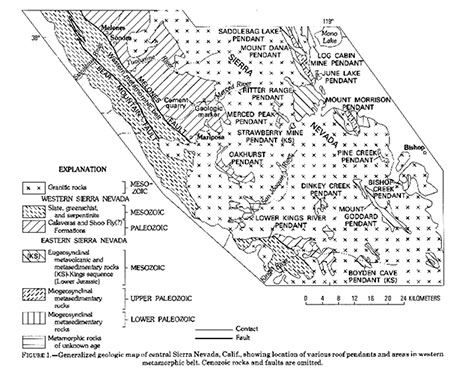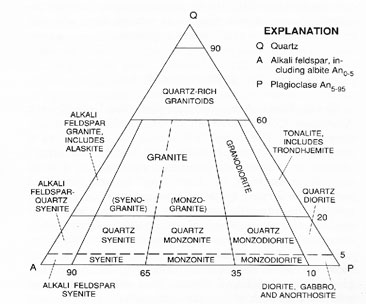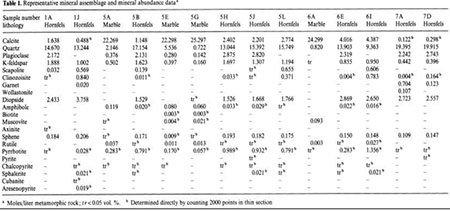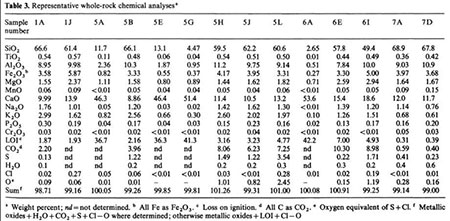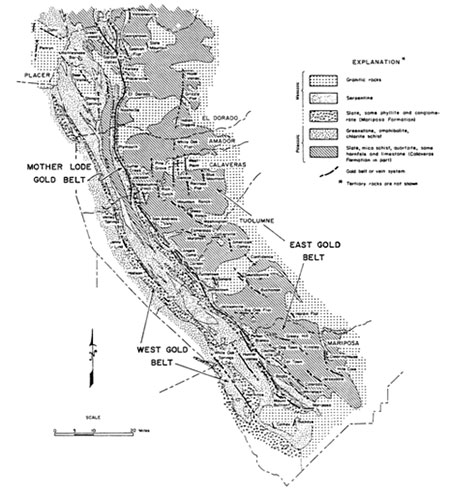Geology and Natural Heritage of the Long Valley Caldera
Roof Pendants of the Sierra Nevada
Garrett Simpson
Abstract
The Sierra Nevada mountain range consists of a vast array of different geologic features. One of these features is in the form of what are known as roof pendants. Roof pendants span through the central and southern portions of the eastern Sierra Nevada. Representing the geologic history of the Sierra Nevada mountain range in California, metamorphic roof pendants offer a glimpse into the past. These features can be described in large scale as a discontinuous chain of metamorphically altered rock dating back before the Sierra Nevada batholith formation. Defined by Paul C. Bateman [1992], a roof pendant is "A mass of metamorphic rock that is entirely surrounded by plutonic rock and presumed to be a downward projection of rocks that overlaid the plutonic rocks before erosion." In this report, an overview of the roof pendants within the Sierra Nevada range is given. Specifically, it was found that the processes that resulted in roof pendants took place in the Paleozoic and early Mesozoic age. Using data from several sources, it was also concluded that metasomatism, and contact metamorphism played the biggest roles in the formation of the roof pendants. Data from research on these features is immense. Because most scientific reports on the roof pendants deal with one specific pendant per report, much data can be reported on this topic. To deal with this, general trends were identified by correlating scientific work done on separate roof pendants.
Introduction
The Sierra Nevada roof pendants represent a characteristic example of the phenomenon known as contact metamorphism. Ted Konigsmark, author of Geologic Trips: Sierra Nevada [2003], explains that these roof pendants are a discontinuous belt of mountains comprised of metamorphosed rocks. The roof pendants of the Sierra Nevada give insight into the complex geologic history of the region. The steep structures present today that are referred to as roof pendants are the remains of igneous and marine sedimentary rock formed during the Paleozoic and early Mesozoic age. Coined from the way in which they were formed, the term roof pendant comes from the fact that they are remnants of the rock that were present above the Sierra Nevada batholith during formation. Konigsmark notes that these metamorphic features present in the eastern Sierra Nevadas of California are a one specific example of the general process that is undergone when giant plutons of magma rise and morph the surrounding bedrock.
Geologic Setting
On a large scale, the Sierra Nevada mountain range was created by the induction of what is known today as the Sierra Nevada batholith. Mary Resendes [2012] describes that the batholith was actually a series of multiple plutons ranging from 80 to 150 million years old. As massive amounts of granitic magma rose to the surface, subsequent uplift, tilting, and erosion exposed the large spire shaped peaks that are the roof pendants. It can be said that the remnants that are still in existence today are the portions of the metamorphosed sedimentary and igneous layers of the roof pendants that were especially thick and hard relative to the sections that have been eroded away [Resendes, 2012]. The below simplified diagram (Figure 1) represents an overview of the process that results in the creation of roof pendants.
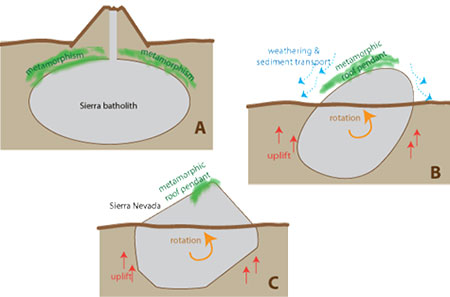
Figure 1 2011 K. Allison Lenkeit Meezan, Foothill College
Roof pendants are well studied in this area for the main reason that they are a valuable economic mineral deposit. Specifically, the contact metamorphism that created these formations has resulted in vast deposits of gold, silver, and tungsten. Complex chemical changes occurred in the country rock due to an increase in temperature, pressure, and fluid amount. This area of the Sierra Nevada has played an important role in the history of the economics of mining and the economy of the surrounding population. The amounts of precious metals found to exist along the roof pendants led to many scientific studies being done in this area, and thus much is known about the formation of these features. In Figure 2 below, an overview of the general geology of the best studied roof pendants of the Sierra Nevada is given.
Figure 2: Noklebergk W. [1981]
Observations
Metasedimentary Units
Metasedimentary rocks define the vast majority of the metamorphic rocks that consist of the roof pendants of the Sierra Nevada. Today, these metamorphic units are mainly defined on the eastern side of the Sierras [1981].
Metaigneous Units
In addition to metasedimentary rocks in the sierra roof pendants, a big constituent also lies in metaigneous rocks. According to Nockleberg, these units provide a geologic record of the calc–alkaline batholith and the events resulting from its volcanic activity. Complex mixes of metavolcanic rocks are distributed throughout the central Sierra Nevada, and most all of them relate to one another despite small chemical differences. For instance, the Strawberry mine roof pendant, along with the rocks in Merced Peak both archive middle Cretaceous period volcanic activity. These metavolcanic units that occur in these two locations are also found to be of similar age in regions such as Mount Dana, Ritter Range, and Rush Creek [Nokleberg, 1981].
Granite Plutons
With the Sierra Nevada batholith comprising of a large percentage of the present day Sierra Nevada mountain range, it is not a surprise that there are many granitic plutons throughout the roof pendant range [Resendes, 2012]. Ron Elan and Warren Thomas explain the contact point between the plutons and the country rock of the roof pendants represent the location of most all of the metamorphism within the area of study. The individual plutons in the individual roof pendants vary in number and degree from pendant to pendant. Despite this, it seems that most of the small plutons that are dispersed within the roof pendants are similar in composition to other plutons within the pendants. Plutons ranging from diorite to felsic dikes are spaced throughout [1984]. In the following figure, the IUGS classification of plutonic rocks is shown. From the modal percentages, one can distinguish between types of plutonic rocks. The three most common minerals that are used to classify these rocks in the following diagram are; quartz, alkali feldspar, and plagioclase feldspar. Because the degree of complexity within the Sierra granitic plutons, it is not appropriate within the context of this paper to include all of the compositions. A separate research paper could be written on the sole topic of the Sierra plutons.
Figure 3: USGS Professional Paper 1483
Metasomatism/Contact Metamorphism
It is general knowledge that the main forces of metamorphism in this region are contact metamorphism as well as metasomatism. Per John Ferry [1989] of The Johns Hopkins University, the general makeup of the metamorphic rock types in the roof pendants are those consisting of slate, phyllite, schist, greenstone, marble, and hornfels. Characteristic signs of hydrothermal alteration riddle the landscape as well. Ferry conducted a study of metasomatism in the roof pendants of Hope Valley, California. Samples were collected from four separate locations, and all samples were of calcareous hornfels (metamorphosed marl) and of marble (metamorphosed limestone). The reason that Ferry chose to center his study on these metacarbonate rocks was due to the fact that they are good indicators of hydrothermal interactions in rock. In the first of the two tables below, mineral assemblages of each sample that Ferry analyzed is shown. The second table lists the same samples as in the first table, but modal percentages of oxide components are instead displayed.
Figure 4: Contributions to Mineralogy and Petrology, 1989
The above table lists mineral components of the different samples in the Hope Valley vicinity. The biggest difference between the samples of hornfels and marble lies in their respective components of Calcite and Quartz. Samples with very high amounts of Quartz are the hornfels samples, while Calcite rich samples are characteristic of the samples of marble.
Figure 5: Contributions to Mineralogy and Petrology, 1989
The rock samples were all fine grained, and the mineral chemistry of each sample was calculated by measuring points in thin sections of rock using reflected and transmitted light. By looking at the above table, one can see that the samples of marble contain high CaO amounts, while hornfels analyzed are distinguishable by their high SiO2 content.
Ore Deposits
It is no wonder that California is named the "Golden State," as the deposits of gold, silver, tungsten, molybdenum, and copper have been an important factor in shaping the economy of the state. The map below shows the special relation of the deposits of gold in the Sierra Nevada in relation to the geologic rock types.
Figure 6: USGS
Sierra Nevada gold deposits in roof pendants have been mined since the middle 1800s according to Bateman [1992]. Most notably, the Coarsegold, Mountain View Peak, Mount Morrison, and Ritter Range roof pendants have all produced operational gold mines. Commonly found in metaigneous rocks, or greenstone, veins of quartz containing gold and silver can be found throughout many of the roof pendants.
Tungsten, as well as gold and silver, has been an important economic mineral of the roof pendant range in California. In 1941, a U.S. geological survey report from Dwight M. Lemmon [1941] keyed that large scheelite bodies were present near Bishop California, at and around the contact of metamorphosed limestone and granitic bodies. A large, 5.5 mile long by 1 mile wide pendant known as the Pine Creek pendant consisting of metasedimentary rock was found to contain scheelite, an important ore containing tungsten. At the time, the Pine Creek mine was one of the largest producers of tungsten in the world. Tungsten, being a valuable strategic mineral used in the hardening of metal alloys, was needed in large amounts during World War II. This being said, the Pine Creek mine proved to be one of the most important mineralogical developments in the Sierra Nevada.
Interpretations
Using analysis of the data given by multiple sources, it can be concluded that several factors played into the creation of the roof pendants of the Sierra Nevada. It can be said that the pendants are a complex network of metamorphosed rock surrounded by plutonic rock. Because of the diversity and complexity of these formations, it is hard to fit a total interpretation into this paper. That being said, a general overview of the mineralogy and structure of the pendants can give insight into the history of this portion of the Sierras. Ferry says that the protoliths of these metamorphic rocks were made up of limestone, siltstone, sandstone, marl, and various volcanic rocks. Warren J. Nockleberg’s results in The Stratigraphy and Structure of the Strawberry Mine Roof Pendant, agree with Ferry that these rocks were present before the Sierra Nevada batholith was formed. The oldest lithological units in the series of metasedimentary rocks are marine sediments such as limestone and marl that are now metamorphosed. Most of the sedimentary layers present above the batholith were destroyed during the time of intrusion. The fine grained, sedimentary and volcanic rocks present before the inclusion of the sierra batholith are now in the form of marble, schist, and phyllite. Mainly due to an increase in temperature, these metamorphic rocks of the roof pendants all underwent contact metamorphism [Konigsmark, 2002].
Deposits of economic minerals such as gold and tungsten in Sierra roof pendants can be explained through the metamorphism of the area. Paul C. Bateman [1992] explains that almost all ore deposits were already present in the country rock, and were then concentrated by the Sierra batholith. Tungsten ore deposits are the exception to this. The presence of tungsten in the Pine Creek mine stemmed from the mixing of magma holding tungsten and components of the country rock. This is known by the way in which the ore deposits are found. Instead of finding the tungsten in veins of quartz, they are found in more massive, metavolcanic layers.
Summary:
The Sierra Nevada mountain range represents one of the most complex and diverse areas known to exist in the science of geology. Comprising of multiple compounding geologic events, the roof pendants of the Sierra Nevada are a complex network of metamorphosed rock. Contact metamorphism, tectonics, and metasomatism dominate the process that formed them. In addition to these processes, an extremely complex history of repeated deformation, erosion, and deposition have occurred in many of the pendants [Brook, 1977].
Marl and limestone that have been metamorphosed into calc–silicate hornfels and marble are the dominate rock types. These geologic formations were created during the Paleozoic and early Mesozoic age. Similar, unmetamorphosed forms of the Sierra roof pendants can be found directly to the east in the Inyo and White Mountains [Green, D. and Stephens, C. 1999]. Tungsten, gold, and other valuable ore of the roof pendants have given them a rich history. Because of this, they have been a source of great economic importance through the history of the United States. Thus, much has been studied about the roof pendants. Distinguishable by sharp, red and brown peaks, the roof pendants of the Sierra Nevada have provided insight into the history of the formation of this spectacular mountain range.
References
Bateman, Paul C. (1992). Plutonism in the Central Part of the Sierra Nevada Batholith, California. U.S. Geological Survey Professional Paper 1483. Print
Brook, C. A. (1977). Stratigraphy and structure of the Saddlebag Lake roof pendant, Sierra Nevada, California. Geological Society of America Bulletin, 88(3), 321-334. website
Elan, R., and Thomas, W. M. (1984). High grade, moderate pressure contact metamorphism in the southern Sierra Nevada, and its tectonic implications for Sierran uplift. Abstracts with Programs. Geological Society of America, 16(6), 500-500. website
Ferry, J. M. (1989). Contact metamorphism of roof pendants at Hope Valley, Alpine County, California, USA; a record of the hydrothermal systems of the Sierra Nevada Batholith. Contributions to Mineralogy and Petrology, 101(4), 402-417. website
Greene, David C., and Stevens, Calvin H. (1999). Stratigraphy, depositional history, and tectonic evolution of Paleozoic continental-margin rocks in roof pendants of the eastern Sierra Nevada, California. GSA Bulletin, 111(6), 919-933.
Konigsmark, Ted. Geologic Trips Sierra Nevada. Gualala, CA: GeoPress, 2002. Print.
Lemmon, Dwight M. (1941). Tungsten Deposits in the Sierra Nevada near Bishop California. United States Department of the Interior. Geological Survey Bulletin 931-E. Print.
Nokleberg, Warren J. (1981). Stratigraphy and Structure of the Strawberry Mine Roof Pendant Central Sierra Nevada, California. Geological Survey Professional Paper 1154. Print.
Resendes, Mary A. "Geology Of The Sierra Nevada." Central Sierra Historical Society. N.p., 2012. Web. 07 June 2013.
Russell, S., and Nokleberg, W. (1977). Superimposition and timing of deformations in the Mount Morrison roof pendant and in the central sierra Nevada, California. Geological Society of America Bulletin, 88(3), 335-345. website
[Return to Research Projects] [Return to Sierra Home]
